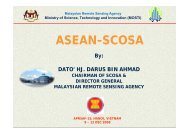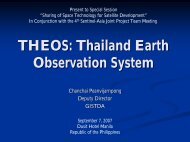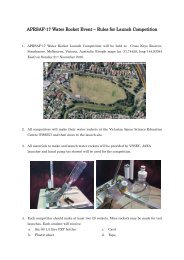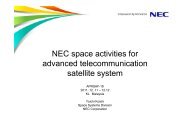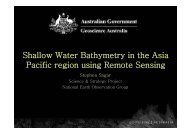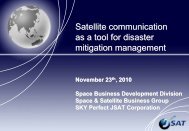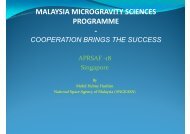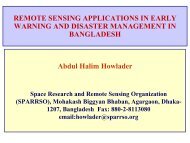Evolution of SAR Satellite for Agriculture Applications - APRSAF
Evolution of SAR Satellite for Agriculture Applications - APRSAF
Evolution of SAR Satellite for Agriculture Applications - APRSAF
Create successful ePaper yourself
Turn your PDF publications into a flip-book with our unique Google optimized e-Paper software.
<strong>APRSAF</strong>-18<strong>Evolution</strong> <strong>of</strong> <strong>SAR</strong> <strong>Satellite</strong> <strong>for</strong><strong>Agriculture</strong> <strong>Applications</strong>Hiroyuki Inahata and Hiroshi KoyamaMitsubishi Electric Corporation7 December, 2011
Table <strong>of</strong> Contents1. Company Pr<strong>of</strong>ile2. MELCO Capability in Earth Observation Field3. <strong>SAR</strong> <strong>Applications</strong> <strong>for</strong> <strong>Agriculture</strong>4. <strong>SAR</strong> Sensor Hardware5. Conclusions2
OsakaConsolidated Net SalesJPY 3,645 billion(US$43.9B)Employee114,4431. Company Pr<strong>of</strong>ileSpace Related Facilities in JapanMELCO’s FacilityJAXA FacilityCommunication Systems Center(Ground Segment)TokyoHead OfficeOsakaSagamiharaAdvanced TechnologyR&D CenterTanegasimaOfunaKamakura KamakuraSagami Plantunder Kamakura Works(Composite Material)JAXATanegashima Space CenterIn<strong>for</strong>mation TechnologyR&D CenterKamakura Works(Space Segment)<strong>Satellite</strong> Operation Center(at Kamakura Works)3
1. Company Pr<strong>of</strong>ileHeritages in Past Space ProgramParticipated in over 450 satellites worldwideAs <strong>of</strong> August. 2011 Over 50 primecontracts including2009- 21 communicationsatellites- 25 observationsatellites4
Weight4.0 t2. MELCO Capability in Earth Observation FieldMELCO heritages in Earth Observation <strong>Satellite</strong>• MELCO has experiences to develop & integrated various kinds <strong>of</strong> observation satellitessuch as large multi-mission plat<strong>for</strong>m(ADEOS1/2), high-resolution imaging satellite(ALOS-2:Synthetic Aperture Radar、ALOS-3:Optical).1990 ~ 2000~ 2010 ~Under Development3.0 t2.0 tADEOS(1996) ADEOS-II(2002) MTSAT-2(2006)©JAXA©JAXAMulti mission Multi missionMeteorologicalLEOGEOHimawari-8 (2014) Himawari-9 (2016)MeteorologicalALOS-2(2013)L-band <strong>SAR</strong>©JAXA1.0 t0.5tJERS-1(1992)SOLAR-B(2006) GOSAT(2009)©JAXA/METI©JAXA©JAXAL-band <strong>SAR</strong> Science Green House GasALOS-3 ©JAXA(under planning)OpticalSLATS(2013)Space Environment & Optical5
2. MELCO Capability in Earth Observation FieldMELCO heritages in Observation Sensors• MELCO has been developing earth observation sensors such as high-resolution &multi band imaging sensor (Synthetic Aperture Radar, Optical)Passivetotal 11OpticalActive1990 ~ 2000~ 2010 ~Under Development©JAXA©METI/JAROS©NAOJ/JAXA©JAXA©JAXAAVNIR ASTER/SWIR AVNIR-2 Solar Telescope CIRC(IR) OPS(planned)ADEOS(1996) EOS-AM1(1999) ALOS(2006) (MDS-2) SOLAR-B(2006) ALOS-3(Planned)ALOS-3(2014) GOSAT-2(TBD)GEOLEOtotal 3Passive©JAXAELISEOptical Data Relay &Tracking equipmentother optical equipment(TBD)RFtotal 6Activetotal 7©JAXA©JAXA©JAXA©JAXAAMSR AMSR-E SMILES AMSR2JERS-1(1992) ADEOS-II(2002) EOS-PM1(2002) ALOS(2006) HTV/JEM(2009) GCOM-W(2011) ALOS-2(2013)<strong>SAR</strong> ©JAXA<strong>SAR</strong> ©JAXA/METI PAL<strong>SAR</strong> ©JAXA/METI <strong>SAR</strong>©JAXA6
3. <strong>SAR</strong> Application <strong>for</strong> <strong>Agriculture</strong><strong>SAR</strong> Application Area• Followings are <strong>SAR</strong> application area <strong>for</strong> agriculture and requiredcharacteristics to extract in<strong>for</strong>mation used <strong>for</strong> agriculture.Agricultural <strong>Applications</strong>• Cropping area <strong>of</strong> rice field• Growth <strong>of</strong> rice crop• Clustering <strong>of</strong> crops• Clustering <strong>of</strong> usage <strong>of</strong> farmland• Farming area• Growth <strong>of</strong> <strong>for</strong>est trees and biomassRequired <strong>SAR</strong> characteristics• Wider swath• Higher spatial resolution• Higher S/N• Full polarimetry• Longer wave length• Higher time resolution• Quick and wide scan• Orbit repeatability7
3. <strong>SAR</strong> Application <strong>for</strong> <strong>Agriculture</strong><strong>SAR</strong> Application Area• Investigation <strong>of</strong> cropping area <strong>of</strong> rice field• Cropping area <strong>of</strong> rice field can be extracted by monitoring the change<strong>of</strong> surface reflectivity• Requirements <strong>for</strong> <strong>SAR</strong> sensor- High resolution < 5m- Wide are coverage > 50km- Quick and wide scanDuring rice planting season,there is water in the rice fieldplantingLow reflectivitywaterHigh reflectivitywatervegetativeDuring harvest season,there is no water in the rice field(Ishizuka, ALOS-2/3 workshop, 2010,http://www.eorc.jaxa.jp/ALOS/conf/workshop/jprog_2_3ws_2010mar.htm)8
3. <strong>SAR</strong> Application <strong>for</strong> <strong>Agriculture</strong><strong>SAR</strong> Application Area• Investigation <strong>of</strong> growth <strong>of</strong> rice crop• Growth process <strong>of</strong> rice crop can be extracted by analyzing “MultipleScattering Mechanisms(Single Bounce, Double Bounce)”.• Requirements <strong>for</strong> <strong>SAR</strong> sensor- High resolution < 5m- Wide are coverage > 50km- Quick andwide scanGrowth Process <strong>for</strong> Rice Crop(1)Be<strong>for</strong>e plantingno bounce‣Surface‣No randomnesssingle bouncedouble bounce(3)Harvest season‣Volume‣High randomness(2)Growing phase‣Double bounce‣Low randomness9
• Clustering <strong>of</strong> crops3. <strong>SAR</strong> Application <strong>for</strong> <strong>Agriculture</strong><strong>SAR</strong> Application Area•Clustering <strong>of</strong> crops can be possible by evaluating difference <strong>of</strong>“Polarimetric” data.•Requirements <strong>for</strong> <strong>SAR</strong> sensor- Full polarimetry HH, HV, VV, VH- polarization isolation > 30dB- High S/N(Signal to Noise ratio) < -25dB *(*Noise equivalent sigma-naught)- Quick and wide scanConeGrassVerticalRefectionHorizontalTransparentHHHVVVVHPotatoOthersBeetRadish(Ishizuka, ALOS-2/3 workshop, 2010,http://www.eorc.jaxa.jp/ALOS/conf/workshop/jprog_2_3ws_2010mar.htm)10
3. <strong>SAR</strong> Application <strong>for</strong> <strong>Agriculture</strong><strong>SAR</strong> Application Area• Clustering <strong>of</strong> usage <strong>of</strong> farmland•Clustering <strong>of</strong> usage <strong>of</strong> farmland is possible by evaluating combination <strong>of</strong>“Backscattering” and “Full Polarimetric” data.•Requirements <strong>for</strong> <strong>SAR</strong> sensor-L-band- Wide area coverage > 50km- Quick and wide scan<strong>Agriculture</strong>Forest<strong>Agriculture</strong>ForestClearcutClearcutL-band is highly permeable andreflects from trunk and groundArii, ALOS-2/3 workshop, 2010, http://www.eorc.jaxa.jp/ALOS/conf/workshop/alos2_ws2/2-5-7_arii.pdf11
• Investigation <strong>of</strong> farming area3. <strong>SAR</strong> Application <strong>for</strong> <strong>Agriculture</strong><strong>SAR</strong> Application Area•3 dimensional mapping data <strong>for</strong> base map <strong>of</strong> farming area can begenerated by using “Interferometry Data”.•Requirements <strong>for</strong> <strong>SAR</strong> sensor- High S/N(Signal to Noise ratio) < -25dB *- Orbit repeatability < 500m(*Noise equivalent sigma-naught)terraced farm areaOkada et.al. Proceedings <strong>of</strong> IGARSS2009,12
3. <strong>SAR</strong> Application <strong>for</strong> <strong>Agriculture</strong><strong>SAR</strong> Application Area• Investigation <strong>of</strong> growth <strong>of</strong> <strong>for</strong>est trees, biomass•Height <strong>of</strong> trees and biomass can be extracted by analyzing “PolarimetoricInterferometry <strong>SAR</strong>” data.•Requirements <strong>for</strong> <strong>SAR</strong> sensor- L-band- Polarization isolation> 30dB- Quick and wide scaninterferometry usingpolarimetiric data suchas HH, VV.TANDEM-L: A MISSION PROPOSAL FOR MONITORING DYNAMIC EARTH PROCESSESProceedings <strong>of</strong> IGARSS2011, Moreira et. al. 2011,13
3. <strong>SAR</strong> Application <strong>for</strong> <strong>Agriculture</strong>Other Application Field by ALOS –PAL<strong>SAR</strong> (L-band)Flood DetectionFlood area(blue)Be<strong>for</strong>eAfterDetected flooded areaFlood Monitoring in Myanmar (Typhoon in 2008)http://www.eorc.jaxa.jp/imgdata/practical/natural/flood.html14
3. <strong>SAR</strong> Application <strong>for</strong> <strong>Agriculture</strong>Other Application Field by ALOS –PAL<strong>SAR</strong> (L-band)Surface Movement by EarthquakeForest MonitoringOil Spill MonitoringSurface Movement after the great eastJapan earthquake 2011Oil spill by the accident <strong>of</strong> tanker in Korea 2011http://www.eorc.jaxa.jp/imgdata/practical/natural.htmlhttp://www.iges.or.jp/en/fc/pdf/20080324reed/10.Isoguchi.pdf15
4. <strong>SAR</strong> Sensor HardwareOverview <strong>of</strong> ALOS-2 <strong>SAR</strong> Sensor• ALOS-2(Advanced Land Observing <strong>Satellite</strong>-2) is a successor<strong>of</strong> earth observation satellite “Daichi” (ALOS).• ALOS-2 has L-band synthetic aperture radar (<strong>SAR</strong>) system,based on Active Phased Array Antenna (APAA) technology.Data Relay <strong>Satellite</strong>Communication AntennaL-band <strong>SAR</strong> Antenna©JAXADirect Transmission Antenna“Development <strong>of</strong> Active Phased Array Antenna <strong>for</strong> ALOS-2”, 2011 Thailand-Japan MicroWave(TJMW2011),2011, Takehito IGUCHI, Yuji OSAWA and et al.16
4. <strong>SAR</strong> Sensor HardwareALOS-2 <strong>SAR</strong> Sensor Characteristics• ALOS-2 has improved per<strong>for</strong>mance compared with PAL<strong>SAR</strong> <strong>of</strong> ALOS.ResolutionSwathItemSpecificationBasic Observation Mode 3mWide Area Observation Mode 100mHigh Resolution Mode 1-3mBasic Observation Mode 50kmWide Area Observation Mode 350kmHigh Resolution Mode 25kmFrequencyL-band(1.2GHz)Data Amount240M-1Gbps(after compression)observation duty average observation duty: >30%Pointingright-and-left lookingPolarizationSingle / Dual / Quad(Full) polarimetry17
4. <strong>SAR</strong> Sensor HardwareOverview <strong>of</strong> ALOS-2 <strong>SAR</strong> Sensor• ALOS-2 has following capability that is enough <strong>for</strong> agricultural monitoring.Requirements ALOS-2 Per<strong>for</strong>mance• Wider swath> 50km> 50km Basic Obs. Mode> 350/490km Wide Area Obs. Mode> 25km High Res. Mode• Higher spatial resolution• Full polarimetry• Longer wave length• Higher polarization isolation• Higher S/N ratio• Quick Scan• Orbit Repeatability< 5mHH,VV, HV, VHL-band>30dB< -25dBPhased Array< 500m< 3m Basic Obs. Mode< 100m Wide Area Obs. Mode< 1-3m High Res. ModeHH,VV, HV, VHL-band>30dB< -25dBPhased Array< 500m18
4. <strong>SAR</strong> Sensor HardwareConfiguration <strong>of</strong> ALOS-2 <strong>SAR</strong> System• ALOS-2 capability is achieved by following <strong>SAR</strong> system.• ELU controls all <strong>SAR</strong> signal generations and beam management.<strong>SAR</strong> Antenna (<strong>SAR</strong>-ANT)Electric Unit (ELU)IF-UNITFoldedconfigurationRXTXEXSCEXRXDPSCTXDeployedconfiguration“Development <strong>of</strong> Active Phased Array Antenna <strong>for</strong> ALOS-2”, 2011 Thailand-Japan MicroWave(TJMW2011),2011, Takehito IGUCHI, Yuji OSAWA and et al.19
4. <strong>SAR</strong> Sensor HardwareALOS-2 <strong>SAR</strong> Antenna Per<strong>for</strong>mance• ALOS-2 <strong>SAR</strong> Antenna has following per<strong>for</strong>mance.ItemPer<strong>for</strong>manceAntenna typeActive Phased Array AntennaAperture size2.9m(EL) x 9.9m(AZ)Beam steering angle θAZ:±3.5deg、 θEL:±30degPolarization TX H,V,45deg,CircularRX H,V,HV dualFoldedconfigurationθEL:±30degDeployedconfigurationθAZ:±3.5deg“Development <strong>of</strong> Active Phased Array Antenna <strong>for</strong> ALOS-2”, 2011 Thailand-Japan MicroWave(TJMW2011),2011, Takehito IGUCHI, Yuji OSAWA and et al.20
4. <strong>SAR</strong> Sensor HardwareALOS-2 <strong>SAR</strong> Antenna Configuration• ALOS-2 <strong>SAR</strong> antenna is consists from “Radiating Elements” and“RF Modules”.• As “Radiating Elements”, sub-array antenna is adopted.• For “RF Modules”, GaN device is partly used <strong>for</strong> the high power amplifier.AELTSub-array antenna : AELTRadiatingElements“Development <strong>of</strong> Active Phased Array Antenna <strong>for</strong> ALOS-2”, 2011 Thailand-Japan MicroWave(TJMW2011),2011, Takehito IGUCHI, Yuji OSAWA and et al.21
5. Conclusions• MELCO has been involved in the government observation satelliteprograms <strong>for</strong> over 30 years as system prime contractor and has manyheritage <strong>of</strong> LEO observation plat<strong>for</strong>m and components.• MELCO is now developing ALOS-2 to be launched in 2013.• ALOS-2 has state-<strong>of</strong>-the-art L-band <strong>SAR</strong> sensor that has high resolution,polarimetry(HH/VV/HV/VH) and PAA capability. ALOS-2 can contribute tovarious applications <strong>for</strong> agricultural monitoring.• MELCO would like to contribute to <strong>SAR</strong> applications <strong>for</strong> various fieldsand is ready to make detailed discussions <strong>for</strong> future cooperation andcontributions.22



